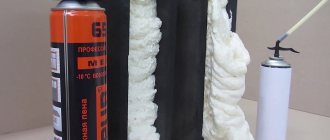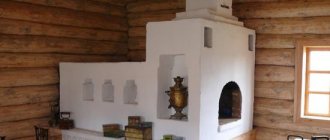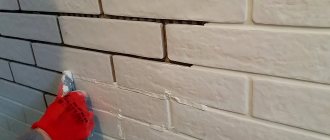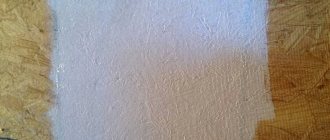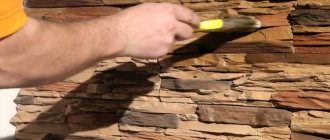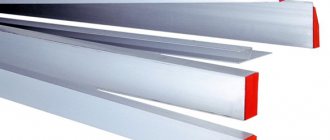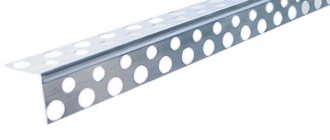What kind of instrument is this?
Leveling the surface after plastering takes place in several stages.
At the first stage, the direction for leveling the plane is set. After this comes the stage where a plaster grater or trowel is used - these are the means by which all unevenness and roughness on the surface after plastering are removed.
After processing these products, the surface is perfectly smooth. This method is used at the end of wall finishing. To get a grater and a grater, not so long ago specialists made them themselves from wood.
Of course, such graters had a short service life, since the wood quickly absorbed water and immediately cracked when the temperature changed. Today, such graters are prepared to a higher quality, but there are also options made from wood that can be purchased.
Such graters and semi-graters are great for grinding and they have many advantages:
- A specialist can work with such graters for a long time without getting tired, since they weigh little and are easy to use;
- Most modern graters do not respond to high humidity;
- The price of such products is not high and they can be purchased at any construction outlets;
- They are bought for a very long time; one grater can process more than 1000 square meters of surface;
- The options for such tools are huge, so it is possible to choose a grater in accordance with the requirements for weight, price, shape, and so on.
Such construction devices have an important feature: they can create both a smooth surface and a textured one if decorative plaster was used.
There are graters that have curved surfaces, thanks to which you can use them to create a beautiful design on the wall.
Most often, the length of the instrument is up to 36 centimeters, its width is up to 18 centimeters, and its thickness is up to 2.5 centimeters. The handle on the grater can be cast or attached separately.
Trowels made by CO.ME.
Factory CO.ME. has 3 lines of trowels in production, as well as several models of non-standard sizes.
This model, an analogue of Oikos, is intended for applying and sanding Venetian lime plaster, artificial Marmorino marble, decor and paints.
This inexpensive model is equipped with a wooden handle, rounded corners, and a sharpened edge of a polished trapezoidal blade 0.6 mm thick. An added benefit is the lightweight, high-quality plastic blade support structure and short blade. The product does not “blacken” when applied.
A model with an ergonomic rubberized handle, excellent quality steel and an additional reinforced aluminum fastening.
Designed for applying and sanding lime plaster (i.e. Venetian) and artificial Marmorino marble, decor and paints.
The product has rounded corners, a sharpened edge of a polished trapezoidal blade, and is available in 3 sizes with a blade thickness of 0.6 mm. The model has a low price. The product also does not “blacken” when applied.
This model is similar to the previous one, but differs in its plastic fastening.
Pros: light weight due to the use of high-quality plastic, comfortable rubberized handle, does not “blacken” when applied. Suitable for use on any Venetian and other plasters, paints and decor.
The answer to the question: “Which trowel is the best among those presented?” directly depends on your preferences and habits, as well as the types of work that you are going to do. After all, there is no clear leader among the presented models.
As for the sizes, trowels with a blade thickness of 0.5 mm are more elastic, they are more suitable for applying and polishing Venetian plasters.
Main trowel sizes: 200*80, 240*100, 280*120. If you need non-standard proportions, then you should turn to CO.ME products.
If you have any questions, we will be happy to answer them!
Those who have the means to afford it try to turn their apartment into something resembling a palace, or at least complete the cladding that is close to that of the royal mansions. You just need to choose the appropriate type of Venetian plaster, and any surface in the house will become exclusive and rich. If you want marble on the wall, choose the appropriate Venetian, in the same way you can make the ceiling, plasterboard niches and any surfaces that you have in your apartment. A variety of shapes and designs is provided by the Venetian trowel, which is used by professionals in their work.
How does this tool work?
The principle of operation of such a product is simple: the base itself removes all unevenness on the surface, smoothes them out, resulting in an even and smooth look or with decoration.
The plaster trowel is used in this order:
- The plaster is diluted in a special tray in such a volume that it can be used immediately. Next, the solution is applied to the surface and leveled.
- They take the tool and begin to move it along the still wet wall, pressing it a little. Drive it counterclockwise, you need to have time to level everything until the solution is completely dry.
This tool can also be used on dried plaster. This stage is the final one, after which the surface should become smooth. In this case, the grater is not moved in a circle, but up and down. Having passed one strip on the wall, they move on to another.
For a good result, the plaster must be mixed correctly. If finishing plaster is being done, then the solution should be used only with well-ground particles. If they are large, then it will not be possible to get a smooth finish on the wall.
Purpose and principle of operation
The purpose of the trowel when carrying out plastering work is to apply a building mixture, for example, putty, to areas of surfaces with subsequent leveling of the layer.
Due to the design, it allows you to cover surfaces with plaster in hard-to-reach places, including ceiling corners, after which grouting is carried out.
It is also used to eliminate recesses, cracks and other defects on screeds, when applying plaster markings and other similar works.
When smoothing surfaces or applying plaster mortar to concrete, the tool is moved in any direction.
The goal is to achieve a smooth surface without flaws.
Different types of tools
The main difference between graters and each other is the material from which they were made.
Their operating principle is the same and their appearance is also similar. Scrapers made of the following materials are in great demand: wood, plastic, polyurethane, polystyrene foam and sponge. Made of polyurethane - today they are one of the most popular. They can be used with decorative mortar, lime and gypsum. The thickness of such a grater will be up to 25 millimeters, and their sizes are as follows:
- 120 by 240 millimeters;
- 110 by 600 millimeters;
- 140 by 280 millimeters;
- 180 by 320 millimeters.
The thinnest elongated bases are perfect for decorative plaster; with other thicker bases they can be used for other solutions. Such products are durable, very lightweight, and easy to use.
For polyurethane graters, the best materials are used, which are durable, reliable, elastic, and so on.
Some features when using such products:
- If decorative plaster is used, then the tool itself or the wall should be slightly moistened;
- To ensure a high quality finish, it is cleaned during operation;
- Grouting the solution can only be done on a fresh layer that has not yet completely dried;
- For lime mortar, only a rectangular grater and only 20-25 centimeters thick is suitable.
Made from wood - these are the most common and simple options for graters; today they are not in demand due to the availability of other options. So they quickly absorb water, but any plaster has it, and the wall is moistened during work.
Therefore, the service life of such a product is short, they deform quite quickly, increase weight, which significantly complicates the process of working with a grater. Made from polystyrene foam - not suitable for all types of work, but very cheap.
They are made from high quality foam, which is hard, so this product levels the surface well. This tool is not suitable for creating some kind of decor on the wall. But a foam float perfectly levels gypsum and polymer-based plaster.
It should be remembered that polystyrene foam is still a rather brittle material, so products made from such material must be used carefully. Made of metal - such graters are used in the process of ironing the surface.
During this process, a waterproof film is formed on the wall, helping to protect the wall from the adverse effects of water. Metal products make the surface almost glossy, completely leveling it.
Thanks to the trowel, it is possible to compact even thin mortar on the wall when other products cannot do anything. There are metal floats with a rough base; they are used for rough plaster mortar.
Well suited for plaster applied with certain ladles. For the last layer, a grater with a regular base is already used, which is moved in a circular motion or up and down. There are also graters with a base of metal teeth.
They are used for adhesive solutions that are used for tiles. Made of plastic - such tools are most often used when applying various construction solutions such as plaster, adhesive solutions, putty and other decorative materials.
These products evenly distribute solutions on the wall, remove various defects, and hide seams and roughness.
Unfortunately, such a product will not last long, so if you need a grater for a couple of times, then this one will do just fine. Also, it will not work if the plaster is applied in a thick layer.
Sponge graters and graters - such tools are made of latex, rubber or a special foam sponge. They are used when processing decorative areas or volumetric plaster.
Most often, the base, made of the main material, is located only on the working surface itself, but the body is made of aluminum or polyurethane.
These graters are not used for smoothing the surface, but are suitable for creating decorative designs.
General principles of technology
The final stage of cladding is covering and grouting the plaster with floats. In some cases, smoothing is done instead of grouting, but the tool used is almost the same. The quality of the cladding depends not only on the tool; the composition used for finishing is of great importance. If you use a solution prepared by yourself, then the finishing layer is mixed with fine sand with normal fat content. Coarse sand will give a rough surface, suitable only for laying tiles.
We recommend: Plastering walls: the necessary set of tools for the job
The process of applying plaster.
Important: adding gypsum to lime mortar results in a decrease in strength. Excessive fat content of the composition will result in a large number of grinds and unbroken stripes; fat content is good for smoothing. Skinny compounds do not rub well and are not durable.
If you do not have fundamental knowledge in the field of preparing mortars, then it is better to use ready-made building mixtures. This will significantly save your time and effort. Because if the solution is prepared incorrectly, everything may have to be redone later.
The principle of working with building mixtures.
Grouting plaster with trowels can be done in 2 ways: in a circle and in a sweeping manner. By and large, both methods are parts of a general technology. The only difference is that if you don't require perfect quality, you can opt for round cutting. And for high-quality cladding, both technological methods are used.
Types of grout.
How to rub in a circle
The grater is taken in the hand and pressed tightly to the surface, circular movements are performed mainly counterclockwise. Thus, all elevations and tubercles on the plane are removed with the side of the tool. Small depressions will be filled with cut mortar and compacted to level the surface. The force with which the tool should be pressed is regulated arbitrarily and, as a rule, comes with experience. The instructions themselves are simple; on the more convex parts you should press harder. At depressions, the pressure weakens. As you work, solution will accumulate on the sides of the grater; it must be removed periodically. You should not wait until it flies around on its own, because you are in close proximity to the surface of the wall and the likelihood of the dried solution getting into your eyes is too high. You shouldn’t throw it away either; experienced specialists remove the mass with a wide spatula and immediately fill deep depressions or chips with it. Grouting plaster with floats is a rather long and painstaking process. Over time, the surface will dry out, making it harder to grout. In order to avoid these unpleasant moments, the wall must be constantly moistened with plain water. Professionals use a special “stone” brush for this purpose. With this technology, no matter how hard you try, circular marks from your tool will remain on the wall. If quality is not too important for a given room, for example, in a basement or utility room, then you can leave it that way. But to achieve an ideal result, you should go through the acceleration method.
What is the difference between a grater and a grater?
A grater is the same grater, but it is a little narrower and longer.
That's all the difference. Another other name for a grater is a trowel. It is not used for all surfaces, but for individual areas where the last nuances need to be removed. If you need to level a large area of plaster, then you won’t be able to do this with a trowel; you need to buy a grater.
What is better to use
When choosing a tool, it is necessary to rely on the specific tasks that the master faces, as well as on the level of professionalism of the performer, and the ability to handle such tools.
The most favorite tool among specialists is a grater - it can be used to apply plaster, sand it, and also grout it. The same cannot be said about the trowel.
The most popular tool among professionals is considered to be a product made of polyurethane, which lasts for quite a long time and can be used to solve a large number of surface repair problems.
Pros and cons of different trowels for plaster.
Each type of product has both positive and negative qualities, so the choice depends only on the performer of the work. The advantages of wooden products: low cost, light weight and small size.
Cons: absorbs moisture in a short period of time, loses shape, wears off, poor quality, not long-term use. Advantages of foam floats: low price, excellent troweling of finely dispersed plaster.
Cons: fragile, requires experience to use.
Advantages of polyurethane floats: no experience required to use, lightweight, does not deform over time, suitable for almost all jobs, suitable for large volumes. Cons: High quality graters are expensive.
Advantages of plastic products: not afraid of corrosion, durable, comfortable to hold, lightweight. Disadvantages: not flexible, can break if the temperature increases, suitable for a small area, not suitable for people without experience.
The advantages of sponge trowels: you can work with decorative solutions and create various effects. Cons: they will not be able to create a perfectly smooth surface; if you do not use it very carefully, the sponge may come off the frame.
Advantages of metal floats: used for compacting mortar, perfectly levels porous plaster, perfectly covers seams. Cons: not suitable for regular leveling of plaster, for decoration, high price, corrosion may occur.
Dimensions
The dimensions of the tool depend on the type of plaster for leveling which it is used. Thus, for decorative plastering work, graters with a thickness of 3-5 mm and an oblong shape are used.
For lime mortars, the recommended thickness is 20-25 mm, sizes from 120*240mm to 180*320mm.
Polyurethane grater 120*240mm
The handle can be open or closed, like a door.
For certain types of work, other sizes are acceptable.
Plaster trowels are widely available in construction stores. When choosing a tool, it is better to choose well-known manufacturers that have positively proven themselves in the market.
How to choose a grater
Before buying such a tool, you need to be completely sure that it meets all the buyer’s requirements:
- A high-quality product has a hand holder, it is convenient to take and hold, there are special grooves for fingers;
- The working surface should not have any defects that could damage the wall during alignment. Only high quality material should be used;
- If you need to process a large area, then it is better to take a large tool. Otherwise, the work will progress slowly and tediously. If the area to be processed is small, then you need to use a small grater. In any case, the size of the grater or grater should correspond to the size of your hand;
- If the area to work with is large and open, then it is better to take a long grater. And if the area has existing openings, then a shortened half-grater is better;
- People often make the mistake of confusing a foam grater with a polyurethane grater. These are two different types of products. They have different characteristics and features of use;
- If the wall will be covered with paint, which is also light, then it is better to take a metal plastering tool;
- If you know how to handle a tool made from a porous sponge, it can do the same work as a roller to create a textured pattern;
- Deformed wood products can be used for bark beetle type plastering.
Points in using such tools
Graters and trowels, as mentioned above, are used for grouting walls after a layer of plaster has been applied.
When working, it is necessary that the movements are not sharp, counterclockwise in a circle, and the pressure is not great. Professionals in this matter can move up and down or even in the form of a figure eight.
Most often, one part of the surface is treated first, then move on to another. Before you start working, you need to let the plaster dry a little, while the base of the product is periodically moistened.
Sometimes the tool can be used as a spatula, that is, they even spread wet plaster with it. When you have to work with decorative mortars, you can use a trowel to make stretching movements to create grooves.
To get a pattern in the form of a spiral, make such movements with a sponge or plastic grater. The full texture can be seen when the plaster has dried; individual areas are finished with a trowel when necessary.
Which grater manufacturer is better?
Various companies present their products in the grouting products market. High-quality graters and semi-graters are produced by such well-known companies as Zubr, FIT, DEXX, SibrTech and others. Some of the best options:
- MATRIX 86802 - a product made of polypropylene, has a hard sponge, and its size is 140 by 280 centimeters;
- The Oleinik plaster grater is a stainless steel grater that has a wooden handle and is used for smooth plasters;
- FIT IT 05301 – the base of the product is a foam rubber sponge, suitable for final grinding of mortar;
- Volma sponge grater with a telescopic handle - thanks to its unusual handle, it is very convenient to use.
Of course, all work related to plastering is quite lengthy and difficult. But, thanks to the availability of modern products now, this process can be significantly simplified and accelerated.
You will get perfectly leveled and smooth walls if you choose the right working tool, and most importantly, use it correctly.


